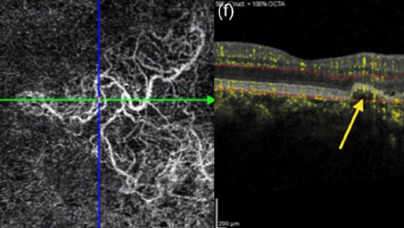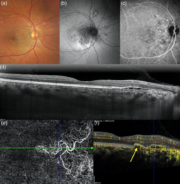
Découverte
Pachychoroïdes : une 7è entité
Une septième entité découverte en 2022 ; mélange entre des néovaisseaux de type 1 (occultes) et le SPP.
Le spectre des Pachychoroïdes recouvre 6 entités :
1- La CRSC (choroïdo-rétinopathie séreuse centrale)
2- L’EPP (épithéliopathie pigmentaire et pachychoroïde)
3- Néovascularisation pachychoroïdienne (NVP)
4- Vasculopathie Polypoïdale Choroïdienne (VPC) ou dilatation anévrysmale de type 1
5- Excavation focale choroïdienne (EFC)
6- Syndrome de pachychoroïde péri-papillaire (SPP)
Non seulement toutes ces pathologies ont en commun la pachychoroïde, mais en plus les patients peuvent passer de l’une à l’autre !
Par exemple, une EPP est une forme chronique et/ou frustre de CRSC/
En 2022, une nouvelle entité a été découverte : un mélange entre des néovaisseaux de type 1 (occultes) et le SPP
Le Syndrome de pachychoroïde péri-papillaire (SPP) est définie comme du liquide sous et intra-rétinien en nasal de la fovéa, dans l’aire péri-papillaire. Cette effusion est due à une hyperperméabilité choroïdienne au pourtour de la papille.
Dans ce cas, il y a un SPP + des néovaisseaux. Ça nous fait une nouvelle abréviation : « NPP » pour néovascularisation pachy-choroïdienne péri-papillaire.
En fait, plus on regarde les choroïdes, plus on trouve de syndromes….
Pour en savoir plus
Peripapillary pachychoroid neovasculopathy: A novel entity Javier Montero Hernández et al.
Eur J Ophthalmol. 2022 Jan;32(1):NP149-NP153. doi: 10.1177/1120672120953071 Epub 2020 Aug 25.

